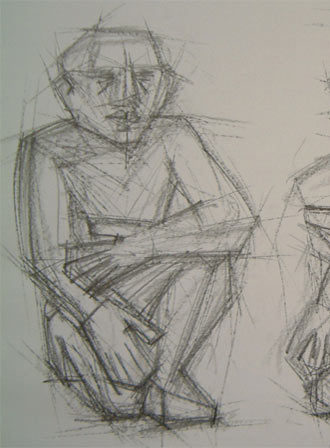
Drawings and Sketches
Drawing - Drawing on Stone - Sculpture
Signs, lines, sketches, notches, scratches
are the oldest testimonies of the human desire to create. A process of development lasting many millennia lay between them and fully plastic monumental sculptures made from rock. The statues of Old Egypt aren't thinkable without the sketches. Still today one can find lines of ochre - applied with a fine brush - on unfinished work pieces.
They precede the subsequent process of creation; they indicate the borders down to which the cutting off of stone has to be done. Already in the quarry the outline of the figure had been scratched into the standing rock. Thus dimensions and proportions were already settled; only after this could the stone be cut out in the intended size.
Still today work pieces that were rejected at this early stage can be found in quarries.
I describe this because the procedures of modern day sculptors basically don't differ from the old methods.
The techniques and tools for working with the stone may have changed, but still today an outline is being sketched onto the surface, and the material being above the sketch will be taken away. Slowly, step by step and from all sides the sculptor works his way into the third dimension.Here now differences in the concept become noticeable. So far I talked about a block of stone that is as far as possible cut to size for the planned figure. I work differently: I start with a rock as I find it, that doesn't possess a regular geometry. The stone defines the shape and the dimensions of the sculpture. The stone and my principles of creation form a synthesis which results in those stone-beings that present themselves to me for some time now. Before and during the process of creation I do sketches; there purpose is to make the stone transparent, to x-ray it, to clarify its masses. Continuously lines will be drawn directly onto the stone. These form the marked lines for the future edges. Thus slowly a three dimensional drawing is being formed - a stone-drawing.
It has proven to be useful to leave the edges (done with a wedge) and the notches (done with a diamond-disc) without further touching up, so as to explicitly bring out the specifics of the stone's material.
Where ever it is possible I leave the surfaces of the original form untreated, to contrast their colour and texture with those of the worked-on surfaces. By this idea of creation of mine the original form of the rock remains recognizable; and I follow my principle: As much stone as possible and as much figure as necessary.
Knut Hüneke, 25.10.06
